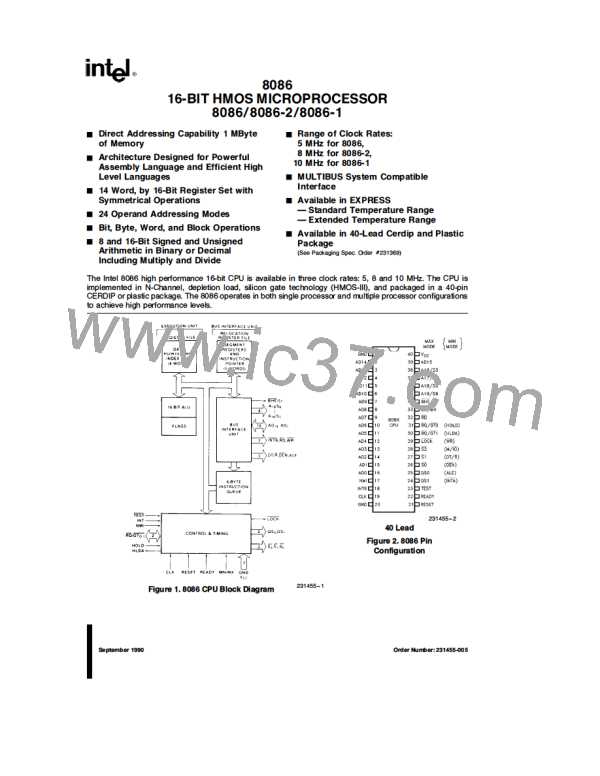8086
Status bits S through S are multiplexed with high-
7
NMI asserted prior to the 2nd clock after the end of
RESET will not be honored. If NMI is asserted after
that point and during the internal reset sequence,
the processor may execute one instruction before
responding to the interrupt. A hold request active
immediately after RESET will be honored before the
first instruction fetch.
3
order address bits and the BHE signal, and are
therefore valid during T through T . S and S indi-
2
4
3
4
cate which segment register (see Instruction Set de-
scription) was used for this bus cycle in forming the
address, according to the following table:
S
S
Characteristics
Alternate Data (extra segment)
Stack
4
3
All 3-state outputs float to 3-state OFF during
RESET. Status is active in the idle state for the first
clock after RESET becomes active and then floats
to 3-state OFF. ALE and HLDA are driven low.
0 (LOW)
0
0
1
0
1
1 (HIGH)
1
Code or None
Data
INTERRUPT OPERATIONS
S
S
is a reflection of the PSW interrupt enable bit.
e
5
6
Interrupt operations fall into two classes; software or
hardware initiated. The software initiated interrupts
and software aspects of hardware interrupts are
specified in the Instruction Set description. Hard-
ware interrupts can be classified as non-maskable or
maskable.
0 and S is a spare status bit.
7
I/O ADDRESSING
In the 8086, I/O operations can address up to a
maximum of 64K I/O byte registers or 32K I/O word
registers. The I/O address appears in the same for-
mat as the memory address on bus lines A –A .
Interrupts result in a transfer of control to a new pro-
gram location. A 256-element table containing ad-
dress pointers to the interrupt service program loca-
tions resides in absolute locations 0 through 3FFH
(see Figure 3b), which are reserved for this purpose.
Each element in the table is 4 bytes in size and
corresponds to an interrupt ‘‘type’’. An interrupting
device supplies an 8-bit type number, during the in-
terrupt acknowledge sequence, which is used to
‘‘vector’’ through the appropriate element to the new
interrupt service program location.
15
0
The address lines A –A are zero in I/O opera-
16
19
tions. The variable I/O instructions which use regis-
ter DX as a pointer have full address capability while
the direct I/O instructions directly address one or
two of the 256 I/O byte locations in page 0 of the
I/O address space.
I/O ports are addressed in the same manner as
memory locations. Even addressed bytes are trans-
ferred on the D –D bus lines and odd addressed
7
0
bytes on D –D . Care must be taken to assure that
15
8
each register within an 8-bit peripheral located on
NON-MASKABLE INTERRUPT (NMI)
the lower portion of the bus be addressed as even.
The processor provides a single non-maskable inter-
rupt pin (NMI) which has higher priority than the
maskable interrupt request pin (INTR). A typical use
would be to activate a power failure routine. The
NMI is edge-triggered on a LOW-to-HIGH transition.
The activation of this pin causes a type 2 interrupt.
(See Instruction Set description.)
External Interface
PROCESSOR RESET AND INITIALIZATION
Processor initialization or start up is accomplished
with activation (HIGH) of the RESET pin. The 8086
RESET is required to be HIGH for greater than 4
CLK cycles. The 8086 will terminate operations on
the high-going edge of RESET and will remain dor-
mant as long as RESET is HIGH. The low-going
transition of RESET triggers an internal reset se-
quence for approximately 10 CLK cycles. After this
interval the 8086 operates normally beginning with
the instruction in absolute location FFFF0H (see Fig-
ure 3b). The details of this operation are specified in
the Instruction Set description of the MCS-86 Family
User’s Manual. The RESET input is internally syn-
chronized to the processor clock. At initialization the
HIGH-to-LOW transition of RESET must occur no
sooner than 50 ms after power-up, to allow complete
initialization of the 8086.
NMI is required to have a duration in the HIGH state
of greater than two CLK cycles, but is not required to
be synchronized to the clock. Any high-going tran-
sition of NMI is latched on-chip and will be serviced
at the end of the current instruction or between
whole moves of a block-type instruction. Worst case
response to NMI would be for multiply, divide, and
variable shift instructions. There is no specification
on the occurrence of the low-going edge; it may oc-
cur before, during, or after the servicing of NMI. An-
other high-going edge triggers another response if it
occurs after the start of the NMI procedure. The sig-
nal must be free of logical spikes in general and be
free of bounces on the low-going edge to avoid trig-
gering extraneous responses.
10

 INTEL [ INTEL ]
INTEL [ INTEL ]